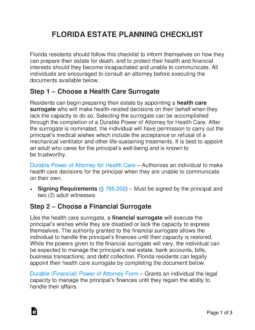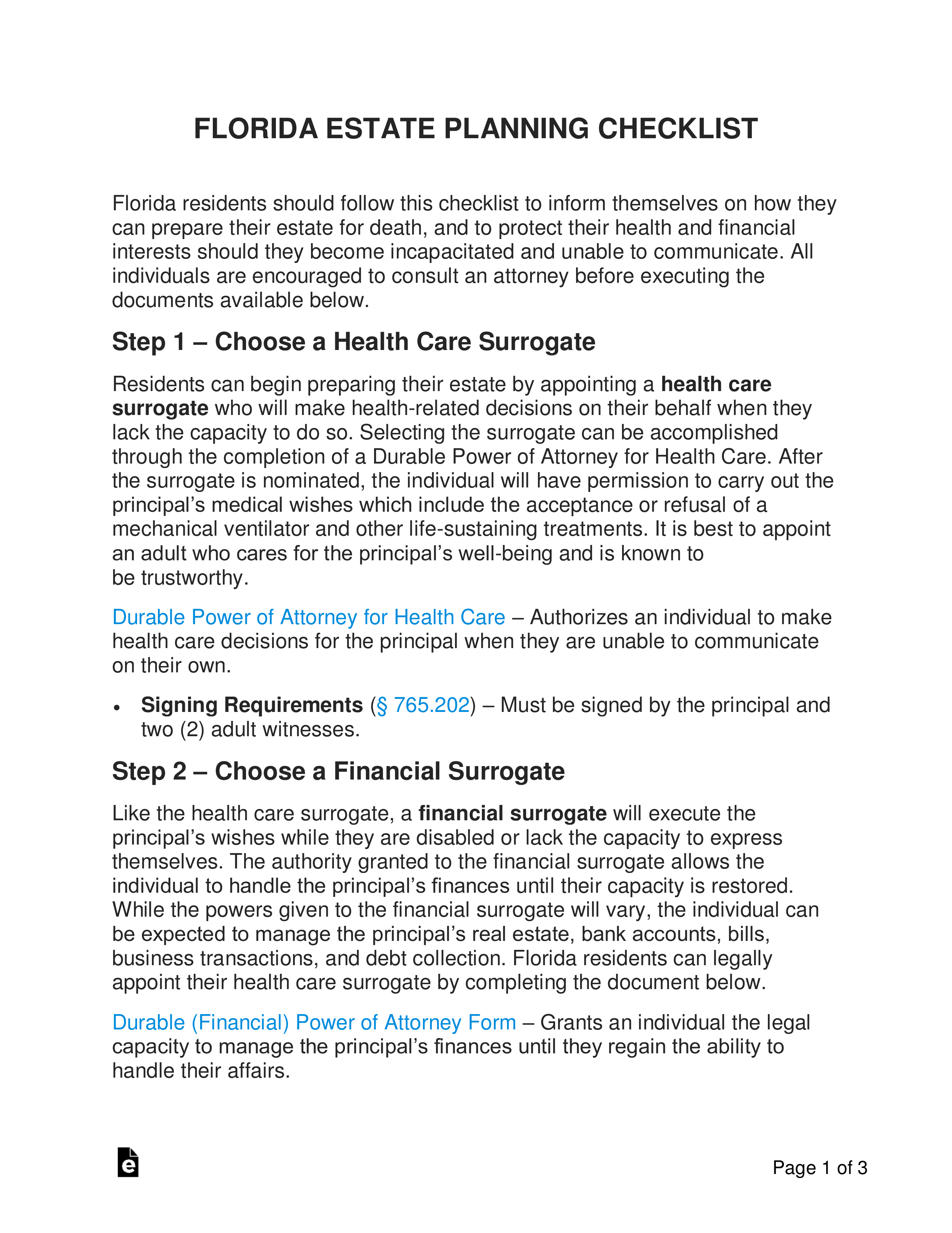Updated March 05, 2024
A Florida estate planning checklist is a guide providing helpful information for those wishing to ensure the security of their well-being and prepare their assets for distribution after death. The owner of the estate, referred to in this checklist as the “principal,” can appoint surrogates to handle their affairs and make decisions on their behalf should they become incapacitated. Selecting these surrogates can be achieved by completing a Durable Power of Attorney for Health Care and a Durable (Financial) Power of Attorney Form. To dictate how one’s assets will be administered, the principal can create an estate distribution document such as a Last Will and Testament or a Living Trust (Revocable).
How to Create an Estate Plan in Florida (6 steps)
- Choose a Health Care Surrogate
- Choose a Financial Surrogate
- Make a List of Personal Property and Other Assets
- Choose the Beneficiaries of the Estate
- Write an Estate Distribution Document
- Protect Estate Documents
Florida residents should follow this checklist to inform themselves on how they can prepare their estate for death, and to protect their health and financial interests should they become incapacitated and unable to communicate. All individuals are encouraged to consult an attorney before executing the documents available below.
1. Choose a Health Care Surrogate
Residents can begin preparing their estate by appointing a health care surrogate who will make health-related decisions on their behalf when they lack the capacity to do so. Selecting the surrogate can be accomplished through the completion of a Durable Power of Attorney for Health Care. After the surrogate is nominated, the individual will have permission to carry out the principal’s medical wishes which include the acceptance or refusal of a mechanical ventilator and other life-sustaining treatments. It is best to appoint an adult who cares for the principal’s well-being and is known to be trustworthy.
Durable Power of Attorney for Health Care – Authorizes an individual to make health care decisions for the principal when they are unable to communicate on their own.
- Signing Requirements – Must be signed by the principal and two (2) adult witnesses.[1]
2. Choose a Financial Surrogate
Like the health care surrogate, a financial surrogate will execute the principal’s wishes while they are disabled or lack the capacity to express themselves. The authority granted to the financial surrogate allows the individual to handle the principal’s finances until their capacity is restored. While the powers given to the financial surrogate will vary, the individual can be expected to manage the principal’s real estate, bank accounts, bills, business transactions, and debt collection. Florida residents can legally appoint their health care surrogate by completing the document below.
Durable (Financial) Power of Attorney Form – Grants an individual the legal capacity to manage the principal’s finances until they regain the ability to handle their affairs.
- Signing Requirements – Must be signed by the principal, two (2) subscribing witnesses, and acknowledged by the principal in the presence of a notary public.[2]
Financial Powers Allowed
- Collection;
- Payment;
- Safe Deposit Boxes;
- Banking;
- Management;
- Tax;
- Business Interests;
- Personal Interests;
- Health Care;
- General Powers.
3. Make a List of Personal Property and Other Assets
4. Choose the Beneficiaries of the Estate
5. Write an Estate Distribution Document
Next, the principal will need to draft a document that outlines the manner in which the estate will be administered following their death. This paperwork will serve as legal evidence of the principal’s end-of-life preferences. The following documents can be used for this function:
Last Will and Testament (‘Will’) – A standard document that explains the principal’s choices regarding the disposition of property. Creating a last will and testament is relatively simple and can be done without expense. However, when the principal dies, the document must be reviewed by the probate court which may result in a lengthy court proceeding and can require additional costs to cover attorney and other court fees.
- Signing Requirements – Required to be signed by the principal and two (2) witnesses.[3]
Living Trust (Revocable) – Allows the principal to transfer ownership of their assets to an entity that they can control themselves or have managed by another individual. Like a last will and testament, the principal can designate assets to the trust and identify their beneficiaries. The primary difference between the two documents is that a living trust will not be reviewed by the probate court resulting in the potential immediate distribution of assets following the principal’s death.
- Signing Requirements – It is best for the principal to sign the document in the presence of a notary public and two (2) witnesses.
6. Protect Estate Documents
Florida Estate Planning Laws
- Durable Power of Attorney for Health Care – Chapter 765, Part II
- Durable (Financial) Power of Attorney – Chapter 709, Part II
- Last Will and Testament – Chapter 732, Part V
- Revocable Living Trust – Chapter 736, Part VI


